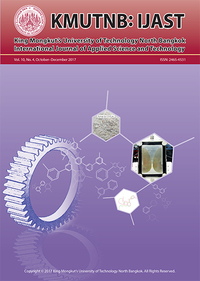Hydrogen-Rich Syngas Production from Biogas Reforming by Gliding Arc Plasma- Catalyst Minireactor
Main Article Content
Abstract
This research aim was to investigate the production of H2-rich syngas from simulated biogas waste using a developed gliding arc plasma minireactor integrated with nickel-based catalysts. The effect of different catalyst types of NiO/Al2O3, NiO/MS 5A and NiO/ZSM-5 zeolite on overall system performance was investigated. Different support types significantly affected physical and chemical properties of prepared catalyst and had the dominant roles on the biogas plasma reforming in different ways. The integration of NiO/Al2O3 catalysts into gliding arc plasma minireactor gave the remarkable enhancement of H2 product in syngas with high H2 selectivity and H2/CO molar ratio of 63.59% and 2.91, respectively. Using NiO/Al2O3 catalyst in this plasma system lead the synergistic effect on H2 selectivity, as compared the only plasma system. NiO/ZSM-5 catalyst provided the highest CH4 conversion of 19.29% and also gave the minimum consumed energy of system (Ec=6.14x10-18 W·s/molecule of biogas converted and Es=5.52x10-18 W·s/molecule of syngas produced). The gliding arc plasma minireactor of this work performed the biogas reforming better than other low-temperature plasma such as conventional dielectric barrier discharge system.
Article Details
References
[2] A. Aziznia, H. R. Bozorgzadeh, N. Seyed-Matin, M. Baghalha, and A. Mohamadalizadeh, “Comparison of dry reforming of methane in low temperature hybrid plasma-catalytic corona with thermal catalytic reactor over Ni/γ-Al2O3,” Journal of Natural Gas Chemistry, vol. 21, no. 4, pp. 466–475, Mar. 2012.
[3] B. Sorenen, Hydrogen and Fuel Cell. Oxford: Elsevier Academic Press, 2005, pp. 6–10.
[4] J. A. Moulijn, Chemical Process Technology. New York: John Wiley & Sons, 2004, pp. 129–139.
[5] R. B. Gupta, Hydrogen fuel: Production, Transport and Storage. New York: CRC Press, 2009, pp. 38–61.
[6] K. Pornmai, N. Arthiwet, N. Rueangjitt, H. Sekiguchi, and S. Chavadej, “Synthesis gas production by combined reforming of CO2- containing natural gas with steam and partial oxidation in a multistage gliding arc discharge system,” Industrial & Engineering Chemistry Research, vol. 53, pp. 11891–11900, Jul. 2014.
[7] N. Rueangjitt, T. Sreethawong, S. Chavadej, and H. Sekiguchi, “Plasma-catalytic reforming of methane in AC microsized gliding arc discharge: Effects of input power, reactor thickness, and catalyst existence,” Chemical Engineering Journal, vol. 155, pp. 874–880, Oct. 2009.
[8] Y. C. Yang, B. J. Lee, and Y. N. Chun, “Characteristics of methane reforming using gliding arc reactor,” Energy, vol. 34, pp. 172–177, Jan. 2009.
[9] Y. N. Chun, Y. C. Yang, and K. Yoshikawa, “Hydrogen generation from biogas reforming using a gliding arc plasma-catalyst reformer,” Catalyst Today, vol. 148, pp. 283–289, Oct. 2009.
[10] Z. A. Allah and J. C. Whitehead, “Plasmacatalytic dry reforming of methane in an atmospheric pressure AC gliding arc discharge,” Catalysis Today, vol. 256, pp. 76–79, May. 2015.


